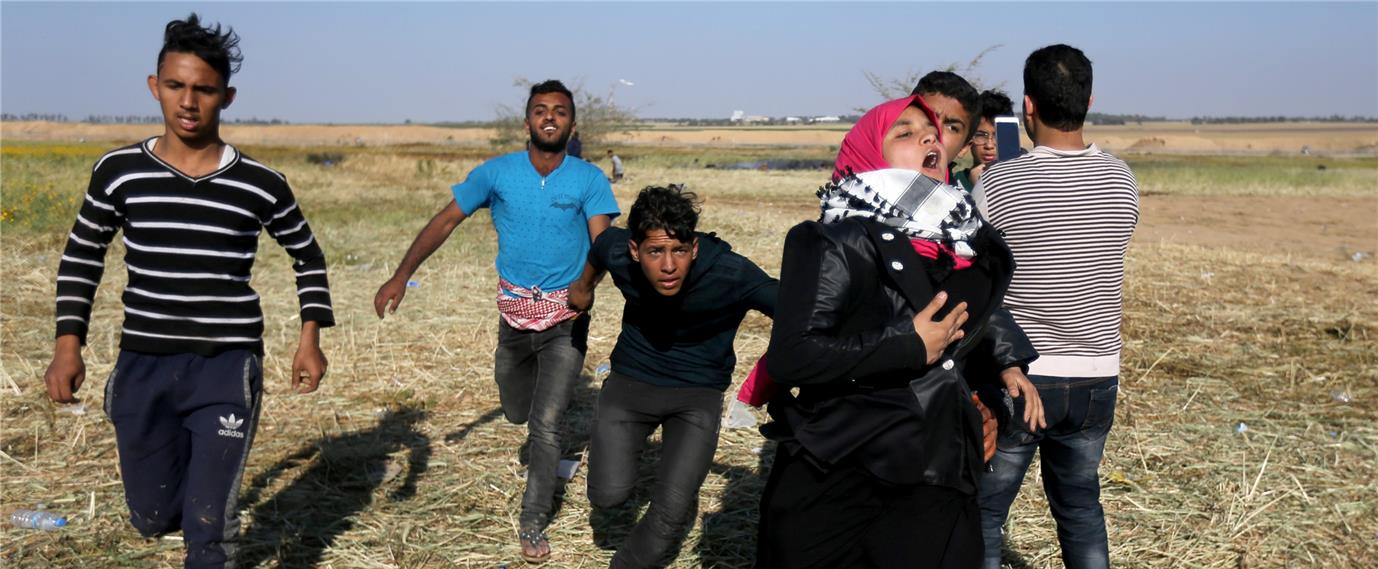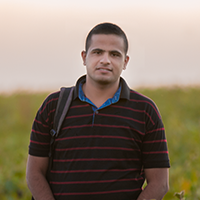لم يمر مشهد مسن كبير كان ممددا أرضا بين سحب دخان الغاز المسيل للدموع، خلال المسيرات السلمية على حدود قطاع غزّة الشرقية، مرور الكرام في حياة المصور الصحفي حاتم عمر بشكلٍ خاص وعلى أبجديات العمل الصحفي الفلسطيني بشكلٍ عام.
كان ثمّة مشاعر إنسانية أقوى من كلّ الصور واللقطات، عندما قرر في لحظةٍ ما أن يترك الكاميرا ويهرع لحمل المسن في محاولةٍ لنقله بعيداً عن الخطر، هذا المشهد الإنساني والذي ظهر في صورة التقطها صحفيٌ آخر، ضجّت بها مواقع التواصل الاجتماعي في منتصف أكتوبر/تشرين أول الماضي.
عن ذلك، يقول عمر: "في تلك اللحظة لم أفكر أبدا في الصورة التي كنت أستعد لالتقاطها، تخيلتُهُ أبي، ذهبت فورًا تجاهه لأنقله لمنطقة أخرى أكثر أمنًا"، لم يحقق عمر السبق لكنه يرى بأنه حقق ما هو أهم من ذلك حين أحي في القلوب قيمة الإنسانية، "فإنقاذ حياة إنسان يظل أفضل من ألف صورة وألف سبق".
تلك القصة التي حظيت بفرصة التوثيق ليست وحدها، فعلى مدار التاريخ القريب، خاصة في ظل الحديث عن مرور ثلاثة حروب طاحنة على غزّة، واستمرار الاعتداءات الإسرائيلية في الضفة والقدس، وأخيرا مسيرات العودة وكسر الحصار المستمرة منذ حوالي سبعة أشهر، عاش مجموعة من الصحفيين الفلسطينيين الاختبار الأصعب الذي لا يفضل أيّ صحفي في العالم خوض تفاصيله، فلا أحد يرغب في أن يُخيّر بلحظةٍ ما، بين التقاط صورة صحفية يمكن أن ترفع كثيرا من شأنه المهني، وبين إنقاذ إنسان قد يكتب له عمر جديد وحياة على يديه.
يوم الـ28 من أكتوبر/تشرين أول 2018 كان مشهدٌ آخر، على الحدود الشمالية البحرية لقطاع غزة، عندما ظهر صحفيان آخران ضمن فيديو انتشر عبر مواقع التواصل الاجتماعي، هما محمد الكحلوت وبلال الصباغ، إذ ألقى الصحفيان معداتهما جانباً وهرعا نحو سيدةٍ فلسطينية كادت تختنق بالغاز المسيل للدموع ونقلاها إلى سيارة إسعاف قريبة.
الإنسان قبل الصورة
العديد من المراجع الصحفية أكدت على قوة العلاقة بين العقل والقلب حتى أثناء ممارسة المهنة، فالصحافة وجدت أساسا من أجل رفعة الإنسان وصونه، "ولا فرق بين كشف مجرم من خلال استقصاء صحفي معمق وتقديمه للعدالة، وبين إنقاذ روح بشرية، فالعملية الأولى سامية لكن الثانية تظل أسمى بكل المقاييس" حسب ما يقول رئيس تحرير الشبكة الفلسطينية للإعلام الإنساني "أنسنة" محسن الإفرنجي. ويتابع: "مهنة الصحافة قاعدتها الأخلاقيات والمبادئ الإنسانية السامية، التي تعد الناظم للعمل وللسلوك والأقلام والكاميرات والمشاعر أيضاً"، مضيفا "المهنة بنيت قبل كل شيء على حب الخير والسلام، لكن بعض الصحفيين تجدهم يقدمون المصلحة الشخصية وبريق الشهرة ومصلحة أحزابهم على فكرة تقديم العون والرسالة التي يجب أن تكون منوطة بأي عمل صحفي".
ويبيّن الإفرنجي أنّ القاعدة الأساسية في العمل الصحفي، تنص على ألّا يتدخل الصحفي في عمليات إنقاذ ومساعدة طالما وجد من يقوم بهذه المهمة، "لأن مهمته توثيق المشهد وهو قد يدفع حياته ثمنًا لذلك، ولأنّ هذا التوثيق هو ما يتبقى بعد انتهاء الحدث، لذا فإنه يعيش صراعا داخليا مريراً خلال تغطيته لبعض الأحداث سيما التي تتعلق بوجود ضحايا وأرواح". على سبيل المثال يكمل: "عندما يكون الصحفي بين موقفين: تصوير جريمة من جرائم الاحتلال الإسرائيلي، ومهمة إنقاذ شخص لا يوجد من ينقذه، فالأولوية هنا بالتأكيد لحياة الإنسان وليس للصورة"، معللاً ذلك بالارتباط الوجداني والنفسي بين الصحفي وبين قضيته المنحاز لها بشكلٍ كامل، كون الحديث هنا عن احتلال.
وفي ذات السياق يذكر الإفرنجي تجربة مر بها صحفيون أجانب شاركوا في تغطية العدوان الإسرائيلي على غزة عام 2014، عندما تركوا الكاميرات وهموا لإنقاذ وإخلاء أطفال من عائلة بكر على شاطئ بحر غزة بعد استهدافهم بقذيفة مباشرة وهم يلعبون الكرة، فكانوا شهوداً على جريمة الاحتلال ووصلوا لهم قبل أن يصل أيّ أحد فتفوقت الإنسانية على قيمة السبق وكان ما جرى.. "وهذا يدل على أن الإنسانية هي أساس تكوين قلب أي صحفي حر في هذا العالم".
مشاهد متعددة
رئيس لجنة المصورين في نقابة الصحفيين إياد حمد يقول: "نحاول كصحفيين أن نكون حياديين ومستقلين في الميدان إلى حدٍ ما، لكنّ بعض المشاهد تكون أمامنا وهي كثيرة بالمناسبة، تأخذك في منطقة بعيدة عن كلّ القوانين والأعراف المهنية، لكنّها قريبة جدا من قلبك كإنسان".
ويلفت إلى أنّه في إحدى المرات بينما كان يغطى أحداث مسيرات العودة، ويسجل مجموعة لقطات للجنود وهم يطلقون الرصاص بشكلٍ مباشر على الشبان المتجمهرين قرب السياج، لاحظ مجموعةً من الأطفال على مقربةٍ من الاختناق نتيجة استنشاقهم الغاز، مضيفاً: "في تلك اللحظة تركت الكاميرا واللقطات الحصرية وذهبت باتجاههم، لم أستطع أن أمنع نفسي من ذلك، مع علمي المسبق أنّ ذلك قد يعرض حياتي للخطر".
حدثٌ كمسيرات العودة، مختلفٌ بكلّ تفاصيله –كما يرى حمد- ويعدّ نقلة جديدة في طبيعة العمل الصحفي الميداني، بكلّ تأكيد ستكون مواقفه مختلفة، مشيرًا إلى أنّ الصحفيين العاملين في فلسطين لطالما غطوا مسيرات في القدس والضفة لكنهم لم يتأثروا بالقدر الذي عايشوه في مسيرات العودة، لذلك أصبحوا جزءًا منها، وفرضت عليهم أفعال قد تسجل ضدهم في حال تعرضوا لإصابة "فالاحتلال يبحث عن ذريعة يبرر بها استهداف الأسرة الصحفية".
ومن جهته يرى المدرب في مجال السلامة المهنية سامي أبو سالم أنّه يجب على الصحفي الالتزام بإجراءات السلامة المهنية في أوقات الحروب والأزمات، وذلك لعدد من الأسباب أهمها، هو وجود مجموعة شروط في العقود الموقعة بين المؤسسات الصحفية وشركات التأمين، التي تستوجب التزام الصحفي بها حتّى يحصل على حقوقه حال تعرض لإصابة أو أيّ خطر آخر.. "التزام الصحفي بمهنته وطبيعتها في الميدان من بين تلك الشروط المتفق عليها، أي أنّه في حال مارس الصحفي أيّ عمل أخر من غير اختصاصه خلال خروجه لمهمة صحفية، مثل المشاركة في إسعاف الجرحى وتقديم المعونات الغذائية، فإنه يخالف تلك الشروط وقد يضيّع حقوقه القانونية والمادية" يردف أبو سالم، منوهًا إلى أنّ وجهة النظر هذه من ناحية قانونية بحتة.
ويوضح أنه كمدرب للسلامة المهنية، يقدم دورات تدريبية في مجاله للصحفيين حتى يتمكنوا من حماية أنفسهم وزملائهم خلال الأزمات والنزاعات، "لكن هذا لا يعني أن يكون الصحفي بعيداً عن الإنسانية حتّى يلتزم بالمعايير المهنية، فدافع الإنسانية يظلّ أقوى وأسبق من أيّ خبر وصورة".
معايشة للتفاصيل
ولا يمكن لنا الحديث عن المواقف الإنسانية وكيف قدمها الصحفيون الفلسطينيون على قيمة السبق الصحفي دون أن نذكر أكثرها قربًا للأذهان دائمًا، فتلك الصورة التي تجمع الصحفي ياسر مرتجى الذي استشهد يوم الـ6 من أبريل/نيسان 2018 حينما كان يغطي أحداث مسيرات العودة وكسر الحصار عند الحدود الشرقية لمدينة خانيونس جنوب القطاع بالطفلة بيسان ظاهر، ما تزال حاضرة لتعود بنا إلى ذلك اليوم حين كانت الصواريخ تدك غزة خلال العدوان الإسرائيلي عام 2014.
وكان ياسر حينها من ضمن طاقم صحفيي شركة "عين ميديا" الإعلامية التي تغطي أحداث القصف والدمار في مدينة الشجاعية شرق غزّة، آنذاك لم يأخذ التفكير من وقته طويلًا قبل أن يترك الكاميرا ويقتحم غبار الركام ليخرج طفلةً بعمر الزهور كادت جثتها تحترق.
الصحفي الشهيد لم يترك الطفلة بعد إنقاذها، فبقي حتى موعد استشهاده=لأخ والأب والصديق والقدوة لها يصحبها للملاهي وأيّ مكان آخر تريده، يسمع لها وتسمع له، لذا كانت بيسان من أكثر المتأثرين بفقده وحزنًا على رحيله.







































